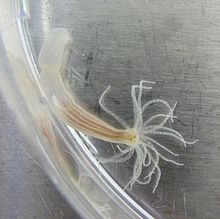Nematostella vectensis
| Starlet sea anemone | |
|---|---|
 |
|
| Scientific classification | |
| Kingdom: | Animalia |
| Phylum: | Cnidaria |
| Class: | Anthozoa |
| Order: | Actiniaria |
| Family: | Edwardsiidae |
| Genus: | Nematostella |
| Species: | N. vectensis |
| Binomial name | |
|
Nematostella vectensis Stephenson, 1935 |
|
| Synonyms | |
|
|
The starlet sea anemone (Nematostella vectensis) is a species of small sea anemone in the family Edwardsiidae native to the east coast of the United States, with introduced populations along the coast of southeast England and the west coast of the United States. Populations have also been located in Nova Scotia, Canada. This sea anemone is found in the shallow brackish water of coastal lagoons and salt marshes where its slender column is usually buried in the mud and its tentacles exposed. Its genome has been sequenced and it is cultivated in the laboratory as a model organism, but the IUCN has listed it as being a "Vulnerable species" in the wild.
The starlet sea anemone has a bulbous basal end and a contracting column that ranges in length from less than 2 to 6 cm (0.8 to 2.4 in). There is a fairly distinct division between the scapus, the main part of the column, and the capitulum, the part just below the crown of tentacles. The outer surface of the column has a loose covering of mucus to which particles of sediment tend to adhere. At the top of the column is an oral disk containing the mouth surrounded by two rings of long slender tentacles. Typically there are fourteen but sometimes as many as twenty tentacles, the outermost being longer than the inner whorl. The starlet sea anemone is translucent and largely colourless but usually has a pattern of white markings on the column and white banding on the tentacles.
The starlet sea anemone occurs on the eastern and westward seaboard of North America. Its range extends from Nova Scotia to Louisiana on the east coast and from Washington to California on the west coast. It is also known from three locations in the United Kingdom—two in East Anglia and one on the Isle of Wight. Its typical habitat is brackish ponds, brackish lagoons and ditches and pools in salt marshes. It is found in positions with little water flow and seldom occurs more than one metre (yard) below the surface. It can tolerate a wide range of salinities, 2 to 52 parts per thousand in southern England, and seems to breed best at around 11 parts per thousand. It is typically buried up to the crown in fine silt or sand, with its tentacles flared out on the surface of the sediment. When not feeding, the tentacles are retracted into the column.
...
Wikipedia

